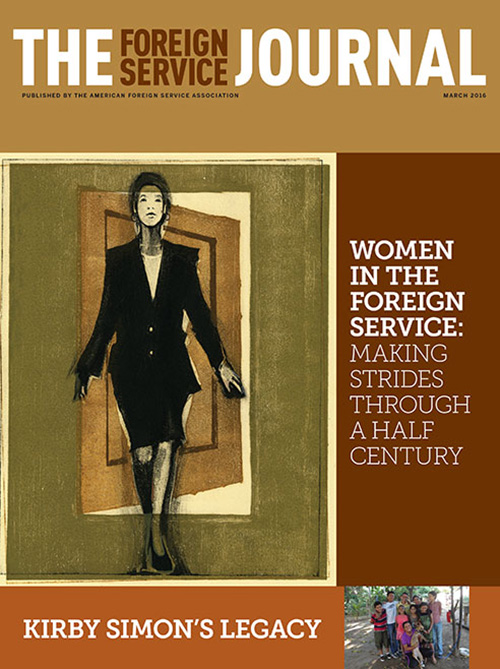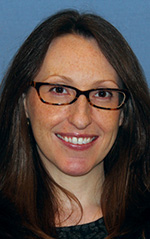Achieving Parity for Women in the Foreign Service
A better understanding of the barriers to women’s advancement—and good data—is needed to continue moving forward.
BY KATHRYN DRENNING

In March 2016, the FSJ considered the topic of women in the Foreign Service, as Editor in Chief Shawn Dorman put it at the time, “with a look back, a look ahead and a few ideas for keeping a positive trend going.”
At his Senate confirmation hearing, Secretary of State Antony Blinken stated: “I’m committed to advancing our security and prosperity by building a diplomatic corps that fully represents America in all its talent and in all its diversity: recruiting, retaining, promoting officers with the skills to contend with 21st-century challenges and who look like the country we represent.” As the board of Executive Women @ State, one of the largest department employee affinity groups (EAGs) with more than 2,000 members, we can see the changes this administration promised already underway.
Women now lead the State Department as Deputy Secretary of State, ambassador to the United Nations and under secretary of State for political affairs, among other senior positions. We applaud the appointments of these accomplished experts in foreign affairs. Secretary Blinken has expressed his support for diversity, equity and inclusion by appointing the first chief diversity and inclusion officer to oversee the department’s efforts, and by meeting with us and other EAGs.
To be sure, this is not the first administration to envision a diverse Foreign Service. Yet despite this oft-repeated goal and nearly a century of effort, our diplomatic Service is far from fully representing American women’s talent and diversity. Women still comprise only 41.9 percent of Foreign Service generalists, 28.9 percent of Foreign Service specialists and 32.4 percent of the Senior Foreign Service (combined generalists and specialists).
And while State continues to make progress on recruiting women, not nearly enough women are moving up the ranks. In 2020, women made up only 28 percent of ambassadors representing the United States overseas, down from an already inadequate 33 percent in previous years. Women of color and women with disabilities, in particular, have been noticeably excluded from these and too many other top positions.
Representation at the Top
Executive Women @ State welcomes this administration’s commitment to diversity, equity and inclusion. We are working tirelessly and in collaboration with fellow EAGs and employee organizations on two immediate priorities: filling senior leadership positions with career Foreign Service and Civil Service women, and stemming the departure of women, particularly at the midlevel, from the department. We see a true opportunity in this moment to achieve great progress toward our vision of gender parity in both numbers and roles for career women at all levels—particularly in the senior levels at State.
Nothing would enhance the status of career women at the State Department more than regularly being selected for top jobs—ambassador and special envoy, deputy chief of mission, assistant secretary and deputy assistant secretary—as well as achieving gender parity in those appointments across bureaus. Drawing from this group before they leave the department will send a clear signal that women can, and will, advance in the Foreign Service. Doing so also would bring the State Department in line with historic practices at the Department of Defense, Central Intelligence Agency and other national security agencies.
Representation at the top will have a significant impact on women’s career advancement in the department, but we must also focus on identifying and removing the institutional barriers keeping women from advancing in greater numbers and driving them to leave before they can compete for top jobs. The 2020 Foreign Service promotion statistics show that women, when given the chance, are competitive; they earn promotion at a higher rate than men. But because fewer women than men are competing, the gender imbalance grows as women advance through the ranks.
Nothing would enhance the status of career women at the State Department more than regularly being selected for top jobs.
For example, once women reach the Senior Foreign Service, they are promoted at a near-equal number. But not enough women get there: As a result, women make up a smaller percentage of the SFS than the ranks up to FS-1, and there are fewer women available to take top jobs. Women make up only 40 percent of the total number of people promoted into the SFS (from FS-1 to FE-OC) and from FS-2 to FS-1, suggesting that something is preventing women from advancing through the midlevels. Among specialists, the promotion statistics show women are concentrated in specialties that begin at lower ranks where fewer opportunities to advance keep them even further from parity after the FS-4 rank.
No one-size-fits-all solution exists for women’s advancement in the Foreign Service. The intersectionality of gender, race, sexual orientation, caregiver status, skill code and other factors creates unique challenges across the department’s female workforce. We won’t achieve gender parity until we understand and address this phenomenon. To begin this effort, we need to identify the barriers to women’s advancement at State. We are encouraged by the department’s ongoing efforts, greatly furthered by the advocacy of EW@S and the EAG / equal opportunity community, to increase data transparency generally.
Identifying Barriers to Advancement
Now we need more data on why women leave the department. We urge State to direct resources toward studying why women are not better represented in senior positions, what pushes women and minorities to leave the department at the midlevel, and what prevents more diverse talent from rising through the senior ranks.
In particular, we have no visibility into how intersectionality plays into Foreign Service members’ experiences in the department and their decisions to leave. But we know from first-person accounts—like the Speaking Out column from six Black, female, Ivy League graduates and members of the Foreign Service in the November 2020 Foreign Service Journal—that they face unacceptable bias in our workplace.

Absent official statistics, EW@S undertook a survey last September that asked our members to rate 22 possible barriers to advancement of women within the department. More than 700 respondents, including 482 members of the Foreign Service, ranked barriers on a scale from zero (no impact) to five (huge impact) from three categories: barriers related specifically to gender, barriers related to family life, and barriers related to workplace challenges. Respondents identified the following three issues as having the largest impact.
Unconscious bias related to gender. Respondents cited managerial assumptions that women with caregiver responsibilities would not want certain kinds of career-advancing assignments; co-worker expectations that women take on housework, social planning and other work to keep an office running that is not deemed “career-enhancing”; and embassy leadership reflections of host-country sensibilities around gender norms—and misconceptions about a woman’s comfort in those environments—when determining the numbers of women attending meetings and official events.
Lack of a mechanism, or its failure, to hold higher-level personnel accountable for gender bias or discrimination. Respondents worried that reporting bias and discrimination from a rater or reviewer would lead to a bad employee evaluation report, as well as negatively affect their corridor reputation—a consequence that directly impedes advancement in the Foreign Service.
A culture that discourages the use of work-life balance flexibilities. Respondents repeatedly described offices where overwork is rewarded and incentivized on an individual basis, even when the department officially discourages it, and where people who use permitted workplace flexibilities are permanently derailed from career advancement.
In addition, the Foreign Service respondents highly ranked barriers like the exclusion of women from informal networks of leadership personnel, and the failure to identify and select them for career-enhancing positions, suggesting that the current design of advancement in the Foreign Service may inherently leave women behind. EW@S has shared the results of this survey with department leadership and is engaging with bureau leaders on how to address these barriers.
Data Needed
All these barriers to advancement have only been exacerbated by the COVID-19 pandemic. The threat of illness and lack of medical care at one’s duty station, the increased caregiving responsibilities brought on by school closures and risk to elderly parents, and the blurring of the boundary between home and work that the pandemic brought about are taking their toll. In the economy as a whole, studies already demonstrate that the pandemic has forced women out of the workforce at alarming rates, with permanent repercussions for their future employment prospects. With this in mind, Executive Women @ State urges State to investigate whether the resignations of women since the pandemic began were connected to that event, and whether the use of provided flexibilities was successful in moderating its effects.
We know that assembling the data we seek will not be easy. The department has been transparent about the limitations of its current systems to produce much of this information. However, several encouraging initiatives are underway to find new ways to gather and analyze these statistics.
To achieve his goal of a Foreign Service that looks “like the country we represent,” EW@S urges Secretary Blinken to fully support these initiatives and provide the resources sufficient to realize their goals. We have the momentum now to make meaningful progress toward gender parity; let’s use it.
Read More...
- “Executive Women @ State: Breaking Barriers,” by Susan Stevenson, The Foreign Service Journal, June 2015
- “Foreign Service Women Today: The Palmer Case and Beyond,” by Andrea Strano, The Foreign Service Journal, March 2016
- “Female, (Won’t) Curtail & Yale: Waiting to Exhale,” by Samantha Jackson et. al, The Foreign Service Journal, November 2020





